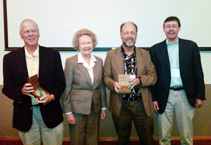Spatz and Steinberg’s ‘1921’ is awarded the 2011 Seymour Medal
 1921: The Yankees, the Giants, and the Battle for Baseball Supremacy in New York, written by SABR members Lyle Spatz and Steve Steinberg, is the winner of the 2011 Seymour Medal, which honors the best book of baseball history or biography published during the preceding calendar year.
1921: The Yankees, the Giants, and the Battle for Baseball Supremacy in New York, written by SABR members Lyle Spatz and Steve Steinberg, is the winner of the 2011 Seymour Medal, which honors the best book of baseball history or biography published during the preceding calendar year.
The authors will receive their medal at the Seymour Medal Conference, May 13-14 at the Radisson Hotel Gateway in Cleveland, Ohio. (For a schedule of events and registration information, click here.)
1921 was published by the University of Nebraska Press.
The Seymour Medal Selection Committee released the following statement about the winning book:
“1921 describes the pennant races in both the National and American Leagues in that year. For the first time, New York had a subway World Series with the Giants and Yankees hooking up. Obviously, with Babe Ruth versus John McGraw, the World Series takes on added meaning given McGraw’s style of play and Ruth’s home runs. The book’s structure in taking the readers through the season, alternating between the two teams and leagues, is to be commended. The authors also provide significant insight into the thinking of the two great managers, John McGraw and Miller Huggins. In their descriptions and also with the help of quotes from the leading baseball columnists of that period, Spatz and Steinberg provide a rich and colorful description of baseball and life in 1921. This is an important addition to baseball literature.”
The other finalists for the 2011 Seymour Medal were:
- Joe Cronin: A Life in Baseball, by Mark Armour (University of Nebraska Press)
- Fifty-nine in ’84, by Edward Achorn (Smithsonian)
- The Last Boy: Mickey Mantle and the End of America’s Childhood, by Jane Leavy (Harper)
Steinberg, the author of Baseball in St. Louis, 1900-1925 and many articles on early twentieth-century baseball, said he was surprised and pleased by the honor.
“There were so many outstanding books written in 2010, just a terrific group of finalists,” he said.
“I thought we covered the season well, the teams, the players. We just let all their personalities come across and what it comes back to for me is the storytelling. That’s what it’s all about.”
Spatz, the author of Yankees Coming, Yankees Going: New York Yankee Player Transactions, 1903 through 1999, chairman of the Baseball Records Research Committee and the winner of the 2000 Bob Davids Award, SABR’s highest honor, said working with Steinberg was “a real pleasure.”
“Authors have collaborated before, but I don’t know how the heck they did it before e-mail and everything,” he said. “We live about as far away as you can possibly get from each other (Steinberg in Washington and Spatz in Florida), but it was no problem at all. We’ve also become friends and, as I understand, that’s not always the case.”
Both writers said they gained a greater appreciation of John McGraw after researching the book.
“He was such a complicated and brilliant manager,” Steinberg said, “although I don’t know if he would be able to succeed in modern baseball with his personality.”
Added Spatz, “McGraw was even more dominant than I realized — in the sense of controlling his team, of calling every pitch even way back in 1921, and really being an iron-fisted ruler. But much like (George) Steinbrenner, who could be a real jerk as McGraw could be, he also had a soft spot. He always had seven or eight ballplayers, old Giants or (Baltimore) Orioles, working for him at the Polo Grounds in various capacities. That’s kind of counter-intuitive … when you think of McGraw’s (reputation).”
The Seymour Medal Selection Committee also released the following statements about the other finalists:
-
On Armour’s Joe Cronin: “This book provided not only a biography of Joe Cronin but also insight on fifty years in baseball. We were very impressed with the research and the manner by which the author provided an unbiased perspective of the issues surrounding Cronin.”
-
On Achorn’s Fifty-nine in ’84: “This book gave a wonderful insight as to baseball at the end of the nineteenth century, on and off the field. Achorn’s depiction of Old Hoss Radbourn‘s performance in 1884 is fascinating. The book also provides a vivid view of life in Providence during this period.”
-
On Leavy’s The Last Boy: “This is not a typical biography. As a result, we learn more about Mickey Mantle the man rather than Mickey as a player. We applaud the level of research, especially in finding out what really happened at Griffith Stadium when Mickey hit the supposedly 565-foot home run.”
The Seymour Medal, named in honor of Dr. Harold Seymour and Mrs. Dorothy (Seymour) Mills, was first awarded in 1996. To be considered for the medal, a work must be the product of original research or analysis. The winning book shall significantly advance our knowledge of baseball and shall be characterized by understanding, factual accuracy, profound insight and distinguished writing.
To see a list of previous winners, click here.
Originally published: April 7, 2011. Last Updated: April 4, 2022.


